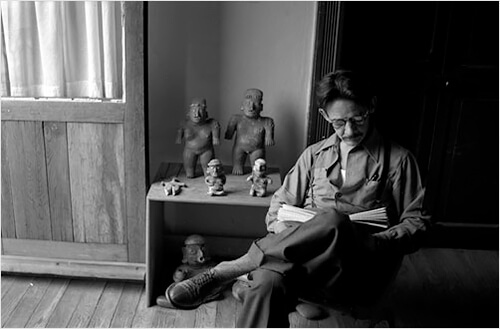Manuel Álvarez Bravo was a Mexican artistic photographer and one of the most important figures in 20th century Latin American photography. He was born and raised in Mexico City. While he took art classes at the Academy of San Carlos, his photography is self-taught. His career spanned from the late 1920s to the 1990s with its artistic peak between the 1920s and 1950s. His hallmark as a photographer was to capture images of the ordinary but in ironic or Surrealistic ways. His early work was based on European influences, but he was soon influenced by the Mexican muralism movement and the general cultural and political push at the time to redefine Mexican identity. He rejected the picturesque, employing elements to avoid stereotyping. He had numerous exhibitions of his work, worked in the Mexican cinema and established Fondo Editorial de la Plástica Mexicana publishing house. He won numerous awards for his work, mostly after 1970. His work was recognized by the UNESCO Memory of the World registry in 2017.
Source: Wikipedia
Manuel Álvarez Bravo, one of the founders of modern photography, is considered the main representative of Latin American photography in the 20th century. His work extends from the late 1920s to the 1990s. Alvarez Bravo was born in downtown Mexico City on February 4, 1902. He left school at the age of twelve in order to begin making a contribution to his family's finances after his father's death. He worked at a textile factory for a time, and later at the National General Treasury.
Both his grandfather (a painter) and his father were amateur photographers. His early discovery of the camera awakened in him an interest that he would continue to cultivate throughout his life. As a self-taught photographer, he would explore many different techniques, as well as graphic art. Influenced by his study of painting at the Academy of San Carlos, he embraced pictorialism at first. Then, with the discovery of cubism and all the possibilities offered by abstraction, he began to explore modern aesthetics. He had his initiation into documentary photography in 1930: when she was deported from Mexico,
Tina Modotti left him her job at the magazine
Mexican Folkways. He also worked for the muralists Diego Rivera, José Clemente Orozco and David Alfaro Siqueiros.
Álvarez Bravo is an emblematic figure from the period following the Mexican Revolution often called the Mexican Renaissance. It was a time of a creative fertility, owing to the happy though not always tranquil marriage between a desire for modernization and the search for an identity with Mexican roots, in which archaeology, history and ethnology played an important role, parallel to the arts. Alvarez Bravo embodied both tendencies in the field of visual arts. Between 1943 and 1959, he worked in the film industry doing still shots, which inspired him to realize some of his own experiments with cinema.
While Manuel Álvarez Bravo was alive, he held over 150 individual exhibitions and participated in over 200 collective exhibitions. According to several critics, the work of this
"poet of the lens" expresses the essence of Mexico. However, the humanist regard reflected in his work, the aesthetic, literary and musical references it contains, likewise endow with a truly universal dimension.
He died on October 19, 2002, at the age of one hundred.
Source: www.manuelalvarezbravo.org
Manuel Álvarez Bravo was a teenager when he first picked up a camera and began taking pictures, before he enrolled in night classes in painting at the Academia San Carlos, in 1917, or sought instruction in the darkroom of local German photographer
Hugo Brehme. Initially self-taught, Álvarez Bravo’s style developed through study of foreign and local photography journals. In these pages, he first encountered the work of
Edward Weston and
Tina Modotti, who came to Mexico in 1923; the latter became a close colleague and supporter, introducing Álvarez Bravo to the artists of Mexico’s avant-garde, including Diego Rivera, Frida Khalo, and Rufino Tamayo, as well as encouraging him to send photographs to Weston.
In the 1930s, Álvarez Bravo met
Paul Strand, traveling with him while he worked in Mexico, and
Henri Cartier-Bresson. With Cartier-Bresson and
Walker Evans he exhibited in a three-man show at the Julien Levy Gallery, New York, in 1935. Mexico was a cultural hub for many in the international avant-garde in these years; André Breton visited, including Álvarez Bravo in the Exposition of Surrealism he organized in 1940 in Mexico City. Although the artist never identified with Surrealism, it was a major theme in the analysis of his pictures throughout his career. Revealing the influence of his formative years following the Mexican Revolution of 1910, Álvarez Bravo would instead speak of his interest in representing the cultural heritage, peasant population, and indigenous roots of the Mexican people in the face of rapid modernization.
Source: Museum of Modern Art

